 If you’re familiar with the FME training course you know how every translation is made up of a hierarchy of components (workspaces/readers/writers/feature types). You also know how each component is controlled through a series of parameters.
If you’re familiar with the FME training course you know how every translation is made up of a hierarchy of components (workspaces/readers/writers/feature types). You also know how each component is controlled through a series of parameters.
In short, parameters are important. They permeate every single aspect of FME and we want to make it as easy as possible for you to use them.
In FME 2017 we did just that. We made BIG improvements in how parameters are set and I want to make sure you fantastic FME’ers are aware of what they are.
![]()
Feature Type Parameters
Firstly, the Reader/Writer feature type dialog got a makeover for 2017. Here’s a screenshot showing the differences (here for PostGIS Writer):

As you can see, this affects parameters because the Format Parameters tab no longer exists! Instead we moved all its content into the first tab. That tab is renamed from General to Parameters too.
Basically it’s a way to remove a tab whose contents didn’t really need to be separate. It’s a small change (though I imagine it took a lot of work to implement) but one that might catch you by surprise if you didn’t know about it in advance.
But, you’re perhaps unlikely to use this dialog as much any more, because of the following great update…
![]()
Parameters Dialog
So, open FME 2017 and what is the first change that you notice? I suspect it may well be this window:
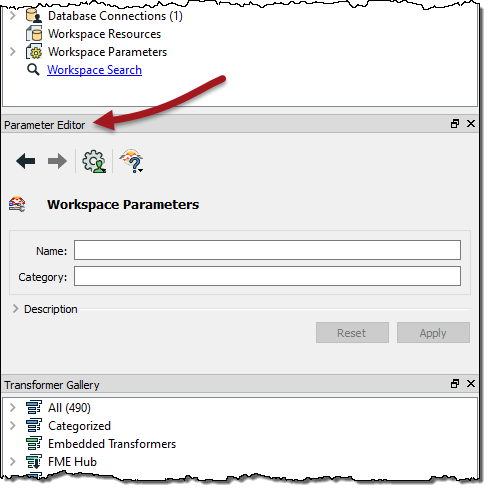
So up until now in FME, to access parameters you needed to click an icon on each component and open up a parameters dialog. This new window provides a single location to set parameters in. For example, click on my PostGIS writer feature type and I see this:
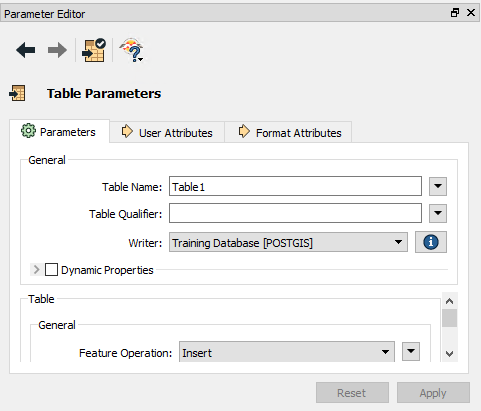
So I can change the feature type parameters (and attributes) without having to go to the specific feature type dialog.
In short, it changes the parameters dialogs from modal to non-modal (if you’re familiar with that term). No more opening and closing dialogs all the time.
“But does this work on transformers too?”, I hear you ask. Well of course:
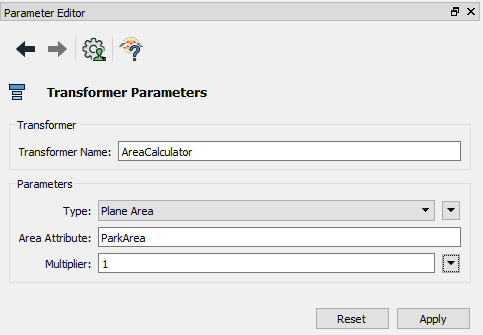
…and on bookmarks and annotations (I’m going to find that really useful):

…and even on connections between objects:
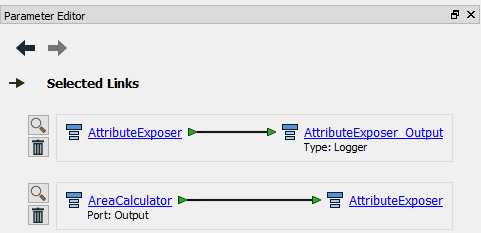
In fact just about anything you can click on in the canvas window. And – you may have already noticed this in the first screenshot – if you don’t click on anything then you get the general Workspace Parameters. Or if you select multiple items then you get the choice of which to set:
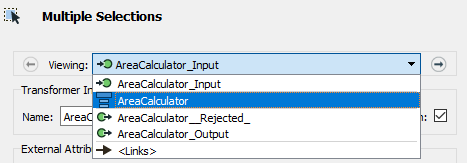
…and notice in the above how we’re inside a custom transformer and have the ability to set Input/Output port parameters here too. Wow! The more I try this dialog the more I love it.
Limitations
I will mention a couple of limitations. Firstly, this doesn’t work on Readers and Writers. I suspect it might be implemented at some point, but we’d probably need a way to represent these on the canvas so you can actually click on them.
The second is less a limitation, but an odd effect: it’s almost impossible to get a yellow icon on a transformer now! That’s because when you place a new transformer its parameters are automatically displayed in this new window; hence the parameters have been displayed and – we assume – checked, so the icon turns directly to blue.
It struck me as a bug when I first saw it happen, but when you think about it, this is the logical behaviour – it just might take some getting used to.
![]()
Other Parameter Stuff
So the Parameter Editor window is a big deal. But besides that there are a couple of minor changes I want to let you know about.
Firstly, in FME 2017 the Workspace Parameters in the Navigator window are all in one (reorganized) section:

If you recall, they used to be in two separate sections (Workspace Parameters, Workspace Properties) – so this is just tidying them up and reorganizing them to be more accessible.
The other change – which is perhaps more important – is an Attributes to Read parameter on reader Feature Types:

If you set that parameter to “Exposed Attributes” then only the exposed attributes will be read from the source. That’s useful – for example – when you only want to read a handful of attributes from a database table. So that way the “Exposed” checkbox turns off the attribute completely, rather than hiding it.
Note that it doesn’t apply to every format. That’s because not every format allows us to select which attributes will be read. So you’ll find that parameter on formats like Spatialite, GeoPackage, CSV (which is a new, more efficient, version of that format), Excel, and most SQL database formats. Formats that don’t support reading attributes separately won’t have this new parameter. In that case un-exposing attributes will just hide them as it did before.
![]()
Summary
To summarize, we’ve made quite a few changes in 2017 to make it easier to access, set, and use different FME parameters; and as much as I like surprising people with nice, shiny presents, it’s probably better you know about these changes in advance.
Then you’ll be able to leap straight in to using 2017 and keep on making all your amazing FME creations!

Mark Ireland
Mark, aka iMark, is the FME Evangelist (est. 2004) and has a passion for FME Training. He likes being able to help people understand and use technology in new and interesting ways. One of his other passions is football (aka. Soccer). He likes both technology and soccer so much that he wrote an article about the two together! Who would’ve thought? (Answer: iMark)




